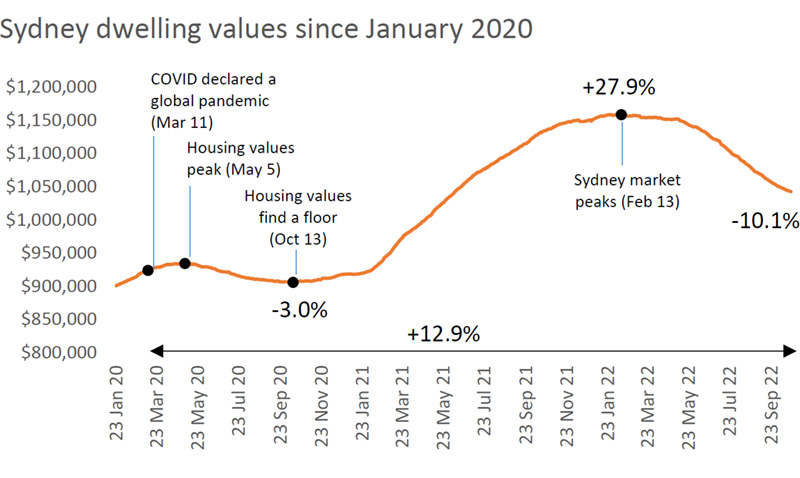RBA's secret expectation of massive price falls revealed
A Freedom of Information request has revealed that the Reserve Bank of Australia expects interest rate rises to push property prices down 20 per cent, with the news emerging as Sydney prices crash through the 10 per cent decline barrier.
On the same day it emerged the Reserve Bank of Australia (RBA) was pencilling in property price falls of 20 per cent throughout its interest rate hiking cycle, Sydney property prices crashed through the 10 per cent price decline landmark.
A Freedom of Information (FOI) document revealed the RBA expected house and unit values to lose a fifth of their value.
Sydney’s property prices skyrocketed more than 30 per cent in 2020 and 2021 before the RBA’s aggressive series of rate hikes, combined with tighter lending standards, slashed property prices.
But if the RBA’s predictions prove correct, much of those gains will be wiped out.
CoreLogic Research Director Tim Lawless said it was unsurprising Sydney was leading the capitals in the current downturn given it is the country’s most expensive capital city housing market and arguably has the greatest susceptibility to rising interest rates.
The city’s homeowners are shedding around $450 a day in value on an average property.
“Although Sydney’s housing values were already in decline when the rate hiking cycle began, the pace of decline accelerated sharply following the first interest rate increase in May,” he said.
“Sydney values are now down 9.5 per cent since 3 May, and by 10.1 per cent since peaking on 13 February this year.”

Source: CoreLogic.
Even with the Sydney market off by $116,500, since the city hit its peak value in February, doubts still remain around its current value.
A report by investment bank UBS rated the Sydney market “highly overvalued”.
UBS warned that the global housing boom was coming to an end.
House price growth in the 25 cities analysed by the report reached its highest pace since 2007 this year, and household debt rose significantly faster than the long-term average.
The UBS Global Real Estate Bubble Index stopped short of labelling the New South Wales capital as being in bubble territory.
“Inflation and asset losses due to current turmoil in the financial markets are reducing household purchasing power, which curbs demand for additional living space,” Zurich-based Claudio Saputelli, Head of Real Estate at UBS Global Wealth Management’s chief investment office, said in the report.
“Housing is thus also becoming less attractive as an investment, as borrowing costs in many cities increasingly exceed the yields of buy-to-let investments.”
No escape
Sydney is the headline act in the declining property market show but the other state capitals are not faring particularly well either.
Melbourne’s values are second to Sydney, falling 6.4 per cent since 14 January 2022 while Brisbane is down 6.1 per cent since its 19 June 2022 peak. Adelaide and Perth have both declined less than 1 per cent since their August peaks.
CoreLogic’s monthly Home Value Index shows Hobart and Canberra both down, 4.7 per cent and 4.4 per cent respectively, since their month-end peaks. Darwin remains the only capital city where housing values haven’t started to trend lower, although dwelling values remain 10.1 per cent below its record high in 2014.
“Despite the 10.1 per cent decline so far, Sydney home values still have a way to go before wiping out the capital gains accrued over the recent growth cycle,” Mr Lawless said.
“Home values would need to fall a further 11.4 per cent to get back to the levels seen at the onset of COVID.
“The good news for Sydney homeowners is that the rate of decline has continued to moderate through October, improving from a 2.2 per cent decline over the four-week period ending 3 September, to -1.3 per cent over the most recent four-week period ending 23 October.”
Some pockets of the real estate market are still delivering capital growth, in particular the prime property market.
The wider national falls come as Australian borrowers have had to contend with interest rate hikes for the past six months in a row, with the official cash rate climbing from a record low of 0.1 per cent to 2.6 per cent.
In the FOI documents obtained by the Sydney Morning Herald, an unnamed RBA economist wrote: “We’re now anticipating housing prices to decline over the next few years.
“That reflects the ongoing slowing in momentum in the market and the steepening of expectations for the future path of interest rates.”
The 20 per cent falls predicted by the unnamed RBA economist were expected to arise by 2024, after falling by 11 per cent by mid-2023.
The RBA’s attempts to reign in a consumer price index (CPI) that currently sits at 6.8 per cent is the basis for the continual interest rate hikes.
Most economists and investors are forecasting more interest rate rises, with markets all but pricing in another 0.25 per cent rise on 1 November, with a peak nearing 4.4 per cent in about one year’s time.


















